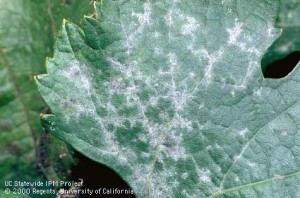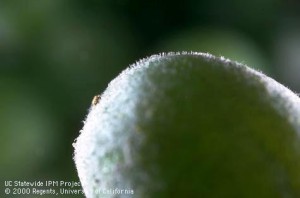![]() This month I would like to share my thoughts regarding how to prevent powdery mildew disease in Chardonnay grapes. For 19 years I worked with Ruby Seedless table grapes in the Reedley area, and that experience shaped my approach to preventing powdery mildew. The Ruby Seedless variety is more susceptible to powdery mildew than wine grape varieties and the growers have a zero tolerance for infections. As a result, my philosophy on powdery mildew prevention is different than that of many people who work with wine grapes.
This month I would like to share my thoughts regarding how to prevent powdery mildew disease in Chardonnay grapes. For 19 years I worked with Ruby Seedless table grapes in the Reedley area, and that experience shaped my approach to preventing powdery mildew. The Ruby Seedless variety is more susceptible to powdery mildew than wine grape varieties and the growers have a zero tolerance for infections. As a result, my philosophy on powdery mildew prevention is different than that of many people who work with wine grapes.
Note that I said “prevent” powdery mildew and not “control.” I do not want to see any powdery mildew on the fruit. I do not want to monitor vineyards for powdery mildew so that I can alert the winemakers to the problem blocks. I do not want to monitor vineyards to determine treatment priorities. I want to monitor the vineyards to confirm that I do not have any mildew on the fruit. Just like table grapes.
__________________________________________________________________________________
The key to powdery mildew prevention in Chardonnay vineyards is to pretend that you are working with a table grape vineyard. Treat the Chardonnay vineyard the same way that you would treat a seedless table grape vineyard.
__________________________________________________________________________________
Many people will advocate the use of the powdery mildew model to guide fungicide applications in Chardonnay vineyards. That may work for varieties such as Zinfandel that are not highly susceptible, but I do not recommend the use of the model for highly susceptible varieties such as Chardonnay. It is similar to my philosophy regarding preventing tooth decay and gum disease. I don’t use a computer model to tell me if I need to brush my teeth after a meal, I just brush after every meal, at least if I am home. I floss every day, even if the “flossing model,” if there were one, says I don’t need to.
 I have a basic template for powdery mildew prevention in Chardonnay vineyards in the Lodi and Clarksburg appellations. I am not recommending that you follow the template exactly, but rather that you use it as a guide. The template is the following: begin sulfur applications at one-inch shoot length and continue every 7 days until 50% berry softening. The key points of the template are to start treatments very early and maintain continuous protection from bud break to berry softening.
I have a basic template for powdery mildew prevention in Chardonnay vineyards in the Lodi and Clarksburg appellations. I am not recommending that you follow the template exactly, but rather that you use it as a guide. The template is the following: begin sulfur applications at one-inch shoot length and continue every 7 days until 50% berry softening. The key points of the template are to start treatments very early and maintain continuous protection from bud break to berry softening.
Although that template will work, there are many possible variations on it that will also work. For example, some growers prefer to start with an oil application rather than a sulfur application. If your first application is with oil rather than sulfur you don’t have to start at the one-inch shoot length, but I would still start earlier rather than later.
During the approximately four-month period that Chardonnay growers need to prevent mildew infections some growers may choose to use synthetic fungicides on occasion rather than sulfur. For example, at bloom or bunch closing some growers may choose to use a synthetic fungicide that prevents both powdery mildew and Botrytis infections. In that case, the sulfur application that the template calls for the following week can be skipped. With some extremely effective fungicides you can even wait 18 days after the application of the fungicide before you need to make your next application.
__________________________________________________________________________________
For more information on prevention and control of powdery mildew, see the Pest Management chapters of the Lodi Winegrowers Workbook (pages 187-267) and the Lodi Rules for Sustainable Winegrowing certification binder (chapter 6).
__________________________________________________________________________________
Some growers may choose to apply a synthetic fungicide prior to bloom, and this is a very common practice in table grape vineyards. In that case, once again, you can skip the sulfur application the following week. The two important factors to remember if you are going to use synthetic fungicides are that you need to rotate among fungicides with different modes of action and you need to get excellent spray coverage. If your spray coverage misses part of the vine then that is the same as doing nothing with regard to that portion of the canopy.
Growers who are applying sulfur will typically do so on an every-other row basis. However, there are situation where the sulfur needs to be applied to every row, not every other row. For example, after the canopy is well-developed, if the vineyard has a history of powdery mildew and is located in a particularly windy area such as the Delta then applications may need to be made to every row every 7 days.
 There is still another factor to consider. If the vineyard canopy is dense then the powdery mildew prevention template, or a variation of it, may not be enough. If the canopy is dense then leaf removal will be needed for a couple of reasons. First of all, coverage by sprays and dusts will be better if the canopy is not too dense. In addition, opening up the canopy will allow for more airflow which aids in powdery mildew prevention by reducing the relative humidity inside the canopy.
There is still another factor to consider. If the vineyard canopy is dense then the powdery mildew prevention template, or a variation of it, may not be enough. If the canopy is dense then leaf removal will be needed for a couple of reasons. First of all, coverage by sprays and dusts will be better if the canopy is not too dense. In addition, opening up the canopy will allow for more airflow which aids in powdery mildew prevention by reducing the relative humidity inside the canopy.
In addition to variety, temperature and light intensity, relative humidity is an important factor in mildew development. Both I and other PCAs have noticed that when there is a wet, damp area in a vineyard, such as an area with standing water, that is where we see mildew first. It is very important to monitor damp areas of the vineyard and to do everything possible to avoid standing water.
We have all heard that “an ounce of prevention is worth a pound of cure” and “a stitch in time saves nine.” Those sayings may not be true in every aspect of life, but they definitely apply in the case of powdery mildew management in Chardonnay. Following my guidelines may result in a couple of dusting sulfur applications, or a spray application, that were not necessary in hindsight. You may waste $20 per acre. However, the economic impact of a powdery mildew problem is much greater.
If you do not adequately prevent powdery mildew then eradicant applications will be necessary which are much more expensive, and less effective, than preventive applications. In extreme cases growers have to send crews through the vineyard to drop infected bunches on the ground. In the worst case scenario the winery can refuse to accept delivery from a mildew-infested vineyard. When faced with those costly possibilities, I think the approach of starting early and maintaining continuous protection is the best way to go.
Thanks for reading. I’m happy to discuss my Coffee Shop posts with you, address any comments and answer any questions you may have. I can be contacted by email at lrwhitted@aol.com or by phone at (209) 327-6472. You can read more about me in this previous post.
__________________________________________________________________________________
Suggest a topic to be discussed by Larry in future Coffee Shop articles by sending an email to lrwhitted@aol.com.
__________________________________________________________________________________

